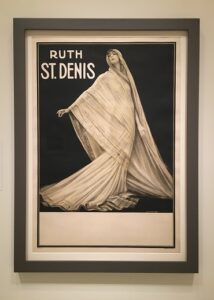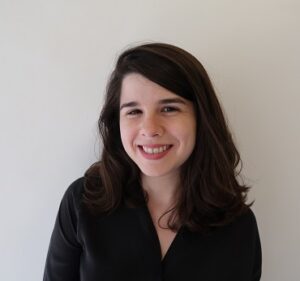By Carolina Meneses
Carolina Meneses is Dance/USA’s first Dance Archiving & Preservation Fellow. Her Fellowship, from July-September 2018, is hosted by UCLA Library Special Collections, and her practicum site is Lula Washington Dance Theatre. Read more about the Fellowship program here. This is the second of six posts from Carolina’s 2018 summer blog. Read the first part here, and the third part here.
August 31, 2018
“Another big takeaway was the notion of an embodied archive, which emphasizes oral and movement traditions.”

Mystery section of Capitol Hill Books
Two weeks ago I was able to attend my first Society of American Archivists (SAA) Conference. In the years past, I considered attending, hoping that it would motivate me to commit myself to apply to library school, but the price of attendance was always too high. I was thrilled then to receive support from Dance/USA to attend this year and I was doubly thrilled that it would be happening in such a vibrant and dynamic city as Washington D.C.
This year SAA’s week-long annual conference was held with two other organizations, Council of State Archivists (CoSA) and the National Association of Government Archives (NAGARA), which made for a thorough, in-depth program. I’ve been to a number of conferences so far, but none as far-reaching as this one. There were so many interesting sessions to choose from, often occurring simultaneously, so that it was difficult to choose which to attend.
Perhaps the most thought-provoking session I attended was Memory Walk and Virtues of Opacity, where panelists discussed different notions and ideas of transparency as they relate to different cultural traditions and the implications these hold for archival work. Since I will be starting my practicum with Lula Washington Dance Theater soon, I was drawn to this presentation as it could offer me different viewpoints on how to build trust and transparency with the dance company. I knew from my own readings about working with dance companies and other living archives that building and maintaining a certain level of trust and transparency from the beginning is essential. This is something that I have paid attention to during my site visits. I’ve noted too that it’s important to keep in mind that an artist’s lack of resources to properly organize their materials does not make them less passionate about their art. What’s more, artists of different cultural backgrounds and genres might have their own idiosyncratic way or philosophy about how they want to save and share their work.

After Soichi Sunami (Japanese/American, 1885-1971) Ruth St. Denis, National Portrait Gallery. Smithsonian Institution.
The panelists eloquently delivered as promised. Aisha Haykal, Manager of Archival Services at College of Charleston, spoke of her work with the Gullah people or “Geechees” and their languages, both verbal and non-verbal. Cheylon Woods, Head Archivist at the Ernest J. Gaines Center told us the story of Gaines, an author born into slavery, through photographs of slave homes in Louisiana similar to the one he grew up in. Woods’ insight was provocative as she challenged Eurocentric archival models and proposed that an archive of the slave experience might only be served best orally rather than textually.
Darra Hoffman, Ph.D student at the University of British Columbia, presented on competing models of transparency and privacy and the dominance of Notice-Choice, the idea that consent to surveillance relies on sufficient notice to the surveillance and the ability to choose to participate or not. And finally, Christiana Dobrzynski, College Archivist at Bryn Mawr College challenged the overemphasis on official documents in her presentation and spoke at length about how “our life is our record”, or the archive exists in one’s body through everyday ritual. She spoke specifically about ephemerality and how mixed nomadic communities have resisted rigid paradigms and models of archival work.
I was really impressed by both Woods’ and Dobrzynski’s presentations, since I’ve been thinking for some time now about how memory is created through the materiality of the archive and how ephemerality and performance by its nature resists being materialized or captured. Another big takeaway was the notion of an embodied archive, which emphasizes oral and movement traditions. This is something that I look forward to in my future with dance archives at large, since I expect the trove of a company’s records to exist inside the minds and bodies of long-time dancers and company members. At Lula Washington I will spend time talking and listening to staff.

Eastern Market, Washington, D.C.
Between networking and sessions, I did get a chance to do some exploring in D.C. Besides visiting museums and other popular sites, I toured the city through what I believe is the best way to get to know a city: by foot, through its food and bookstores. Kramer Books and Busboys and Poets were a must, but my favorite was Capitol Hill Books, a cozy little used bookstore, stuffed to the brim. Despite its dizzying signage situation, I was able to find an early edition of Italo Calvino’s If On A Winter’s Night a Traveler, which I’ve always wanted to read. The bookstore was just steps away from Eastern Market where I enjoyed a delicious soft shell crab sandwich.
I realize how important SAA is to an early career archivist as it provides access to a robust community who support the knowledge necessary to succeed in the field and, in turn, enables me to support my colleagues as my expertise increases over time.
 Carolina Meneses is pursuing a master’s degree in library and information science at UCLA, specializing in archival studies. A second generation Cuban-American from Miami, she received her BA in comparative literature at Smith College where she focused on the intersection of memory, dance, and language. After college, she participated in an archival internship with a dance company based in New York City, which became the foundation for her interest in the contradictory nature of preserving the ephemerality of dance performance for research and reproduction. Carolina is also the recipient of a Mosaic Scholarship from the Society of American Archivists, which provides support for minority students pursuing graduate studies in archival science.
Carolina Meneses is pursuing a master’s degree in library and information science at UCLA, specializing in archival studies. A second generation Cuban-American from Miami, she received her BA in comparative literature at Smith College where she focused on the intersection of memory, dance, and language. After college, she participated in an archival internship with a dance company based in New York City, which became the foundation for her interest in the contradictory nature of preserving the ephemerality of dance performance for research and reproduction. Carolina is also the recipient of a Mosaic Scholarship from the Society of American Archivists, which provides support for minority students pursuing graduate studies in archival science.
____
We accept submissions on topics relevant to the field: advocacy, artistic issues, arts policy, community building, development, employment, engagement, touring, and other topics that deal with the business of dance. We cannot publish criticism, single-company season announcements, and single-company or single artist profiles. Additionally, we welcome feedback on articles. If you have a topic that you would like to see addressed or feedback, please contact communications@danceusa.org.
Disclaimer: Opinions expressed in guest posts do not necessarily represent the viewpoints of Dance/USA.



